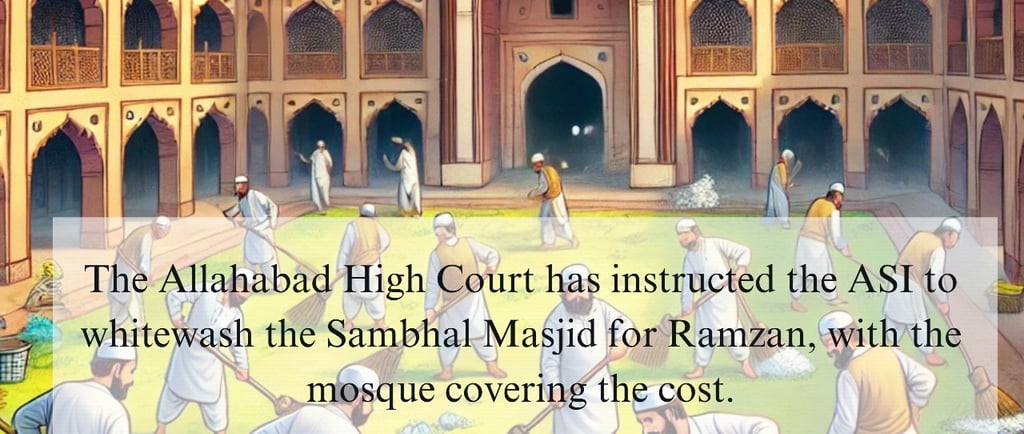The Allahabad High Court has instructed the ASI to whitewash the Sambhal Masjid for Ramzan, with the mosque covering the cost.
The Allahabad High Court has directed the Archaeological Survey of India (ASI) to whitewash the exterior of the Shahi Jama Masjid in Sambhal within a week, with the mosque committee covering the costs.
3/13/20252 min read


The Allahabad High Court has issued a directive to the Archaeological Survey of India (ASI) to carry out whitewashing on the exterior of the Shahi Jama Masjid in Sambhal within a week. The mosque committee has been ordered to bear the expenses for this maintenance work. This decision comes after a legal dispute surrounding the mosque’s upkeep and maintenance, particularly ahead of the Ramzan period.
Earlier, the ASI had argued before the court that there was no need for whitewashing, claiming that the mosque’s structure was in good condition, as it was coated with enamel paint. However, the court found that the ASI had not provided an adequate or convincing response regarding the necessity of whitewashing certain parts of the mosque’s exterior. The court, in its judgment, acknowledged that some areas of the monument had visible flaking, which required attention. Justice Rohit Ranjan Agarwal, who presided over the case, instructed the ASI to complete the whitewashing work on the affected areas within a week, ensuring the mosque committee covers the expenses for the service.
Along with the whitewashing directive, the court also addressed the issue of additional lighting. It clarified that no lighting should be installed directly on the mosque’s walls, to prevent any potential damage to the monument. However, it permitted the use of external lighting, such as focus lights or LED lights, to illuminate the outer parts of the mosque. This ruling was made to ensure that while the mosque remains lit and accessible for devotees during the Ramzan period, the structural integrity of the monument is maintained.
The Shahi Jama Masjid has been at the center of controversy following a series of legal actions and disputes. A civil court had earlier allowed a survey of the mosque based on a suit filed by a group of individuals, claiming that the mosque was built on the site of a demolished temple during the Mughal era. This court order led to protests and violence in Sambhal. The civil court proceedings are currently on hold, as the Supreme Court has passed an order directing lower courts across India to refrain from making any decisions that could alter the religious character of religious structures, pending its ruling on the validity of the Places of Worship (Special Provisions) Act of 1991.
In the meantime, the management committee of the Shahi Jama Masjid had sought permission from the Allahabad High Court to carry out necessary maintenance work at the mosque before the start of Ramzan. This included whitewashing, repairs, cleaning, and the installation of additional lighting to improve the experience for the devotees during the holy month. The committee’s efforts to ensure the mosque was ready for Ramzan were met with opposition from local authorities, including the Additional Superintendent of Police (ASP), North Sambhal, who raised objections, citing the mosque’s status as a protected monument.
The mosque committee then moved the High Court, arguing that similar maintenance work had been carried out in the past without interference from the authorities. The court, after reviewing the situation and hearing both sides, directed the ASI to inspect the mosque and determine the necessity of maintenance, including whitewashing. Despite the ASI's assertion that the mosque was in good condition, the court ruled that the whitewashing of the affected areas should proceed.
This legal battle underscores the ongoing tension surrounding the Shahi Jama Masjid, with the mosque committee seeking to maintain the mosque’s condition, while local authorities and various groups continue to dispute the mosque’s historical significance.j
